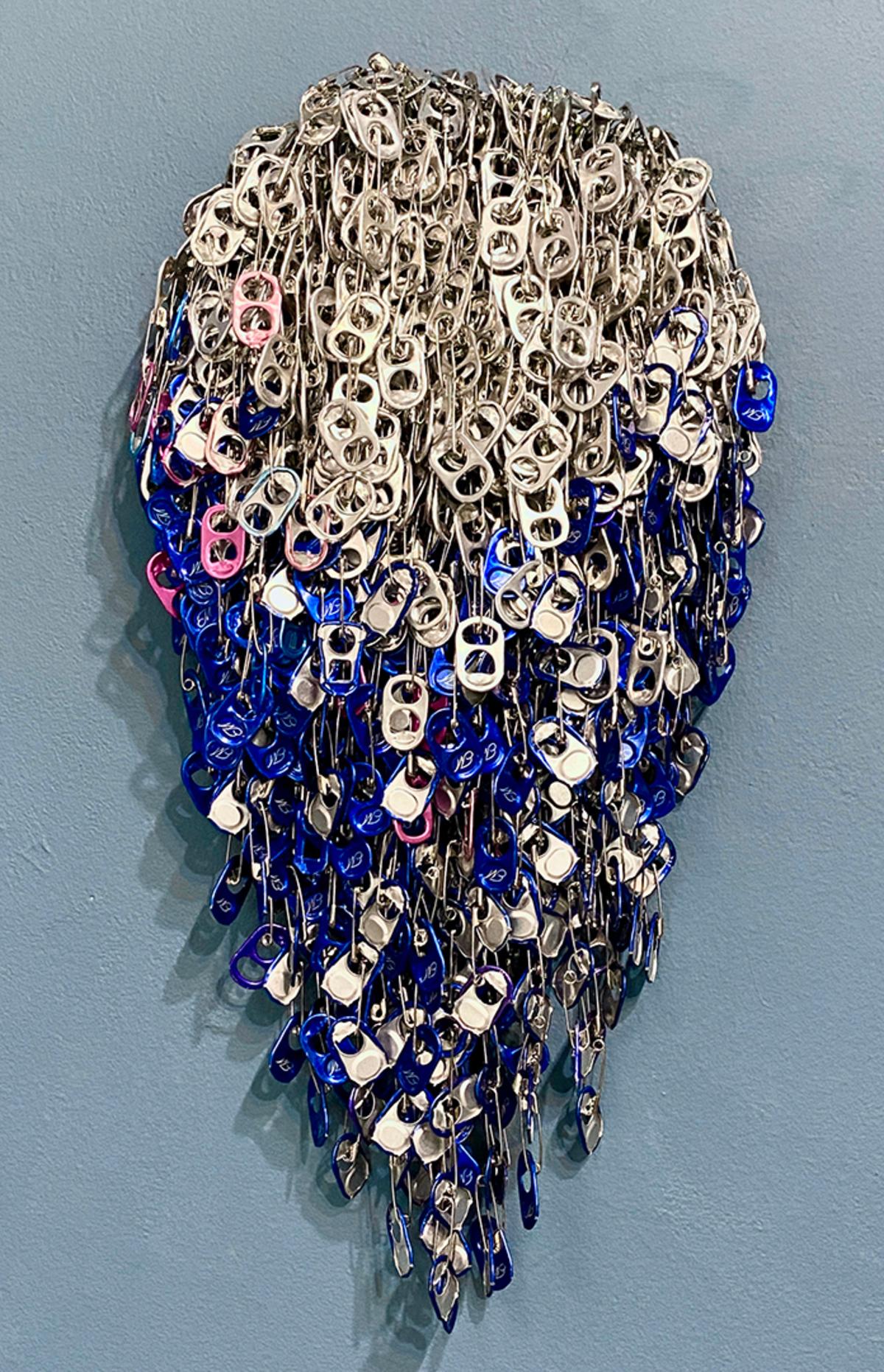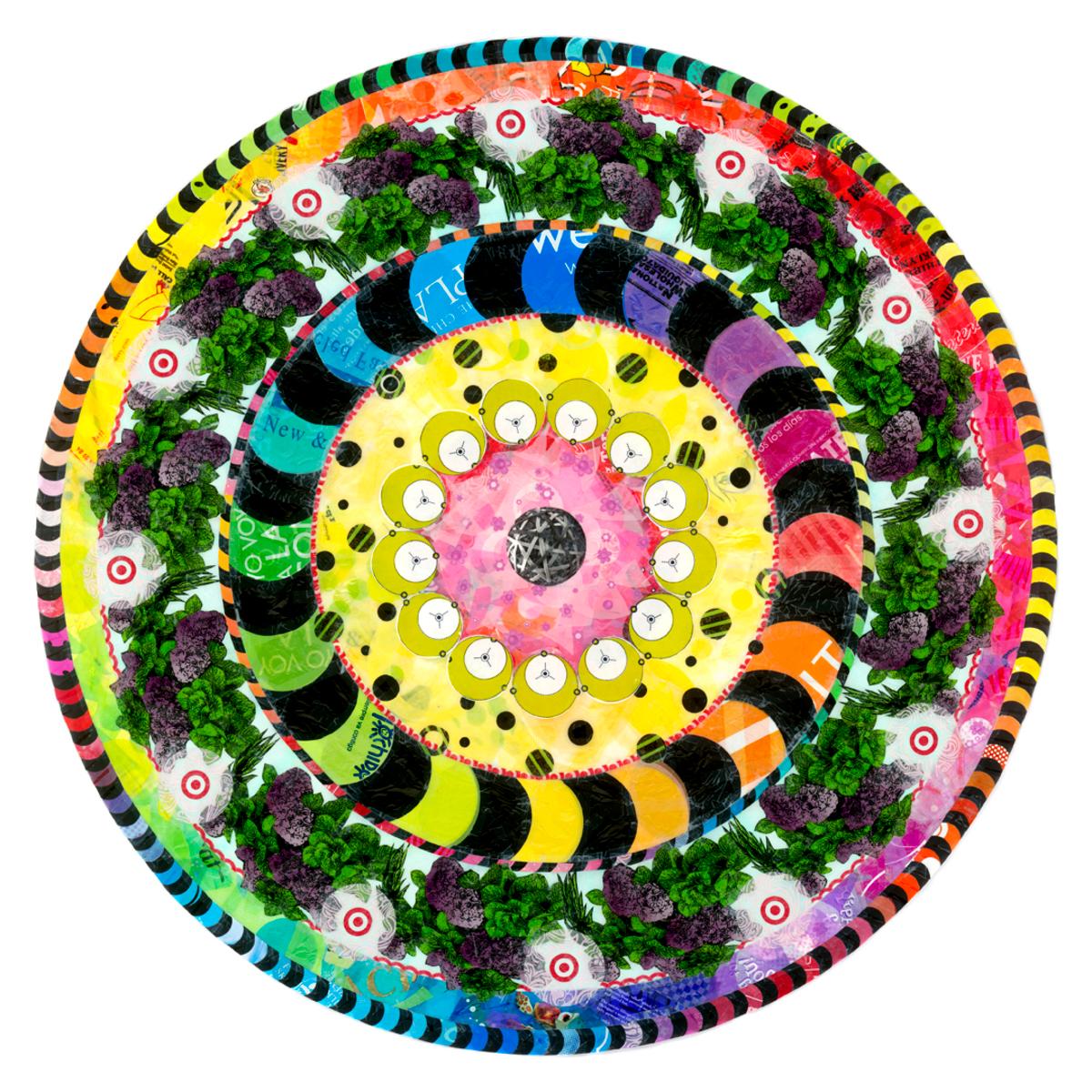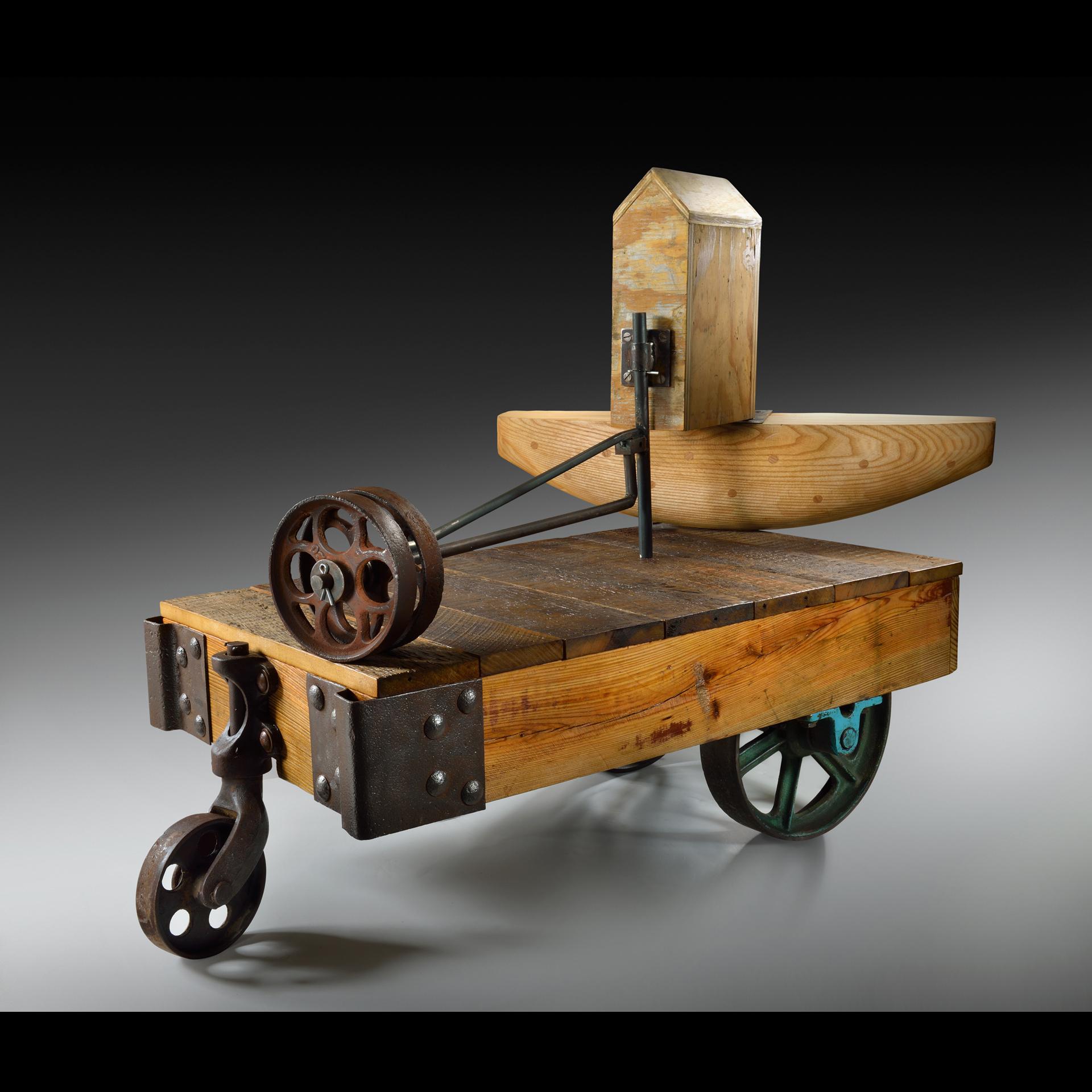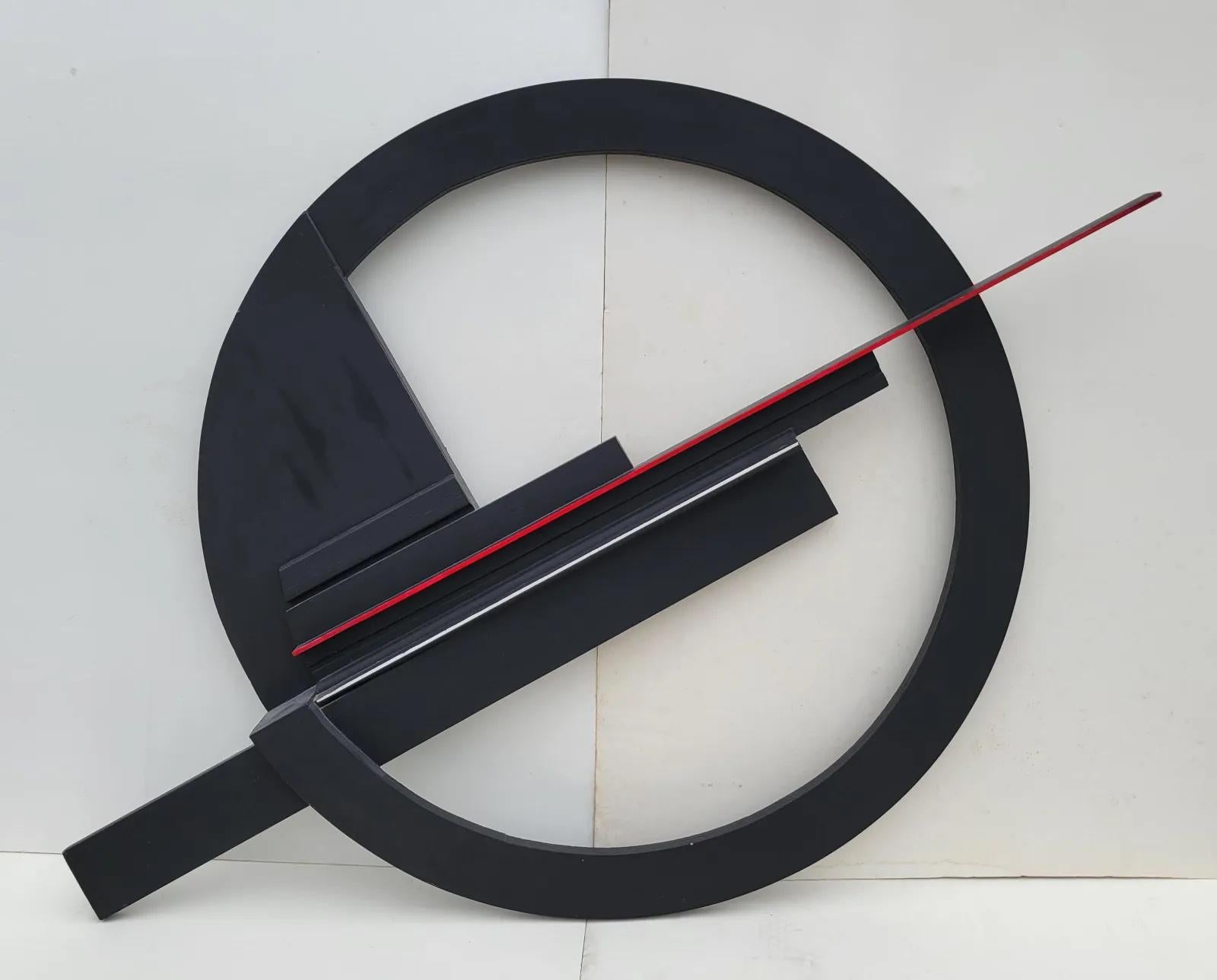Items Similar to John Albert Murphy Porcelain "Dark Days Ahead" Sculptural Nested Bowls
Want more images or videos?
Request additional images or videos from the seller
1 of 10
John Albert MurphyJohn Albert Murphy Porcelain "Dark Days Ahead" Sculptural Nested Bowls2016
2016
About the Item
"Dark Days Ahea" is in fact a glorious paper-thin porcelain sculpture with fluted sides. The "two bowls and one ball" are nestled and permanently fixed. The black and white linear design to the porcelain is relieved by the movement of the fluted sides of the "bowls." This complex design is both light and airy while being visually weighted by the innermost "ball" being covered in a silver glaze suggesting heavy stainless steel. The ceramic piece is slip cast porcelain, masking tape stenciled and glazed in the style of abstract expressionism, specifically Pointillism. It was fired in oxidation at 2230 degrees Fahrenheit. The sphere in the center has luster glaze.
John Albert Murphy heads as the Director the Ceramic Arts Department, the Birmingham Bloomfield Art Center. Murphy takes the reins at the BBAC after working more than 33 years as a program analyst at Ford Motor Co. While carving out a career in manufacturing, Murphy never stopped working in his preferred medium -- clay. His love affair with clay started in his first class with Gawaine Dart at Henry Ford Community College in 1968. Murphy has been teaching ceramic arts since 1986 as an Adjunct Instructor at Wayne County Community College; Henry Ford Community College; Schoolcraft College and Wayne State University.
He holds a Master of Fine Arts degree from Wayne State University, and a BFA from Eastern Michigan University in Ypsilanti. Some other well- known artists who attended Wayne State University are: Arthur Danto, Dr. Wayne Dyer, Tyree Guyton, Hughie Lee-Smith, Philip Levine, Casey Kasem and Helen Thomas.
He is accomplished in all aspects of ceramics, from hand building to wheel throwing and from Raku firing to cone-10 reduction firing in a downdraft kiln. His works can be found in collections as far away as Australia, China, South Korea, Switzerland, and Taiwan. He is currently Program Director of the Michigan Ceramics Art Association, past President of Michigan Potters' Association (1992-93), and member of the National Council on Education for the Ceramic Arts.
- Creator:John Albert Murphy (1950)
- Creation Year:2016
- Dimensions:Height: 4 in (10.16 cm)Diameter: 9.25 in (23.5 cm)
- Medium:
- Movement & Style:
- Period:
- Condition:
- Gallery Location:Detroit, MI
- Reference Number:1stDibs: LU128615465662
About the Seller
5.0
Vetted Seller
These experienced sellers undergo a comprehensive evaluation by our team of in-house experts.
Established in 2014
1stDibs seller since 2019
96 sales on 1stDibs
Typical response time: 4 hours
- ShippingRetrieving quote...Ships From: Detroit, MI
- Return PolicyA return for this item may be initiated within 14 days of delivery.
More From This SellerView All
- John Glick Plum Street Pottery Glazed Bowl Reduction FiredLocated in Detroit, MI"Untitled" is a stoneware piece with the decorative layer of the rich toned glazes and markings that John was so well-known for. Each piece that John produced was unique. The lip on this piece is slightly scalloped and the shape is removed from the boring circular to mimic a gentle geometric design. He was seduced by the effects of the reduction kiln, which decreased the levels of oxygen during firing, inducing the flame to pull oxygen out of the clay and glazes changing the colors of the glazes depending on their iron and copper content. In this way he achieved the rich gradients of ochre and umber and variations in stippling and opacity. This piece is signed and stamped on the bottom. John was an American Abstract Expressionist ceramicist born in Detroit, MI. Though open to artistic experimentation, Glick was most influenced by the styles and aesthetics of Asian pottery—an inspiration that shows in his use of decorative patterns and glaze choices. He has said that he is attracted to simplicity, as well as complexity: my work continually reflects my re-examination that these two poles can coexist… or not, in a given series. Glick also took influences from master potters of Japan, notably Shoji Hamada and Kanjrio Kawai, blending their gestural embellishments of simple forms with attitudes of Abstract Expressionism. He was particularly drown to the work of Helen Frankenthaler whose soak-stain style resonated with Glick’s multi-layered glaze surfaces, which juxtaposed veils of atmospheric color with gestural marks and pattern. He spent countless hours developing and making his own tools in order to achieve previously unseen results in his work with clay and glaze. Glick’s “Plum Tree Pottery...Category
1970s American Modern Abstract Sculptures
MaterialsStoneware, Glaze
- "Ceramic Box with Lid" Stoneware Cream Glaze w/ Organic AttachmentsBy Gawaine DartLocated in Detroit, MIONE WEEK ONLY SALE The rich tones of the stoneware clay come through the soft creamy glaze that drips over the surface like melted vanilla ice cream over red devil cake. There are i...Category
1980s More Art
MaterialsCeramic, Stoneware, Glaze
- Magnificent John Glick Plum Street Pottery "Scalloped Box" Glazed StonewareLocated in Detroit, MIThis magnificent "Scalloped Box" is a stoneware piece with decorative layers of rich toned glazes and markings that John was so well-known for. He was, also, known for the undulating lip lines on his exquisite boxes that fit together like a puzzle. Each piece that John produced was unique. He was seduced by the effects of the reduction kiln, which decreased the levels of oxygen during firing, inducing the flame to pull oxygen out of the clay and glazes thereby changing the colors of the glazes depending on their iron and copper content. In this way he achieved the rich gradients of ochre and umber and variations in stippling and opacity. This piece is signed and stamped on the bottom. John was an American Abstract Expressionist ceramicist born in Detroit, MI. Though open to artistic experimentation, Glick was most influenced by the styles and aesthetics of Asian pottery—an inspiration that shows in his use of decorative patterns and glaze choices. He has said that he is attracted to simplicity, as well as complexity: my work continually reflects my re-examination that these two poles can coexist… or not, in a given series. Glick also took influences from master potters of Japan, notably Shoji Hamada and Kanjrio Kawai, blending their gestural embellishments of simple forms with attitudes of Abstract Expressionism. He was particularly drown to the work of Helen Frankenthaler whose soak-stain style resonated with Glick’s multi-layered glaze surfaces, which juxtaposed veils of atmospheric color with gestural marks and pattern. He spent countless hours developing and making his own tools in order to achieve previously unseen results in his work with clay and glaze. Glick’s “Plum Tree Pottery...Category
Late 20th Century American Modern Abstract Sculptures
MaterialsStoneware, Glaze
- Breathtaking John Glick "Scalloped Basket" Glazed Stoneware Reduction FiredLocated in Detroit, MI"Scalloped Basket" is a stoneware piece with the decorative layer of the rich toned glazes and markings that John was so well-known for. He was, also, known for the undulating lip lines on his exquisite pieces. The basket portion is shaped with gentle curves and a sculptural handle. Each piece that John produced was unique. He was seduced by the effects of the reduction kiln, which decreased the levels of oxygen during firing, inducing the flame to pull oxygen out of the clay and glazes changing the colors of the glazes depending on their iron and copper content. In this way he achieved the rich gradients of ochre and umber and variations in stippling and opacity. This particular "basket" also has the cool blues and grays that contrast with the umber. It is signed and stamped on the bottom. John was an American Abstract Expressionist ceramicist born in Detroit, MI. Though open to artistic experimentation, Glick was most influenced by the styles and aesthetics of Asian pottery—an inspiration that shows in his use of decorative patterns and glaze choices. He has said that he is attracted to simplicity, as well as complexity: my work continually reflects my re-examination that these two poles can coexist… or not, in a given series. Glick also took influences from master potters of Japan, notably Shoji Hamada and Kanjrio Kawai, blending their gestural embellishments of simple forms with attitudes of Abstract Expressionism. He was particularly drown to the work of Helen Frankenthaler whose soak-stain style resonated with Glick’s multi-layered glaze surfaces, which juxtaposed veils of atmospheric color with gestural marks and pattern. He spent countless hours developing and making his own tools in order to achieve previously unseen results in his work with clay and glaze. Glick’s “Plum Tree Pottery...Category
1970s American Modern Abstract Sculptures
MaterialsStoneware, Glaze
- Walter Midener "Contemplation" Seated Figure Clay Sculpture Mid-Century ModernLocated in Detroit, MISALE ONE WEEK ONLY “Contemplation” is an abstract clay sculpture of a female. The figure has both arms and legs extended, but the dignified pose suggests an intimate rather than a sexual moment. The sculpture is delicately rendered, but monumental in pose and clean composition reminiscent of the English artist Henry Moore. The surface is warm and slightly rough to the touch. This sculpture is in the round and beautifully balanced geometrically with the hands clasped behind the head forming a slightly flattened polygon shape that is echoed in the positioning of the legs and draped fabric of a presumed dress. The figure draws the viewer into her contemplation, peace and confidence. An exceptional piece by Midener. Walter Midener...Category
Mid-20th Century Modern Figurative Sculptures
MaterialsClay
- UNTITLED, Abstract/Figurative, Black Welded Steel, Cass Corridor Artist, DetroitLocated in Detroit, MISALE ONE WEEK ONLY The "Untitled" abstract sculpture by Robert Sestok has a very deliberate aura of strength in its columnar shape. It does become more ...Category
21st Century and Contemporary Abstract Expressionist Abstract Sculptures
MaterialsSteel
You May Also Like
- Mirabile Composto (Enchanted Composition) - Leather and Stone Abstract SculptureBy Angelo CanevariLocated in New York, NYAngelo Canevari's "Mirabile Composto" is a 106.3 x 106.3-inch leather and stone abstract sculpture composed of 12 elements. This piece is part of a limited number of works where Canevari engaged in a different medium than bronze. The title "Mirabile Composto" comes from a 17th-century quote describing the work of the famous Baroque Italian artist Gian Lorenzo Bernini. It refers to Bernini's fusion of architecture, sculpture, and painting. In this work, Canevari skillfully plays with different shades of leather and a river pebble to blur the distinction between painting, sculpture, or architectural pieces. The piece projects a magnetic presence. It reminds the immensity and peacefulness of the golden sand mounds in the Sahara desert when viewed from an aerial view. Angelo Canevari is an Italian sculptor from a long lineage of artists active in Rome since the 17th century. He has been commissioned several works by the Vatican, including the Bronze Doors of the Cathedral of Belluno and the Vatican Coins.Category
1980s Assemblage Abstract Sculptures
MaterialsStone
- Liberty MandalaBy Virginia FleckLocated in Boston, MAArtist Commentary: I challenged myself to create complex patterning on this piece. This mandala is made from post-consumer plastic bags Keywords: collage, abstract, assemblage Details: This is a wall mounted scuplture made from post consumer can-tabs and safety pins mounted on green MDF. A hanging cleat is attached on back. signed on back. No paints are use in this piece. The can-tabs are manufactured in many colors according to thier brand. Artist Biography: Since 2002, award winning artist Virginia...Category
21st Century and Contemporary Assemblage Abstract Sculptures
MaterialsPlastic, Board
- Treasure 7.8 (with blue silver and pink)By Virginia FleckLocated in Boston, MAArtist Commentary: Made from post consumer can-tabs. Can-tabs can be found in a rainbow of colors according to their brands. The blue are from Michelob beer and the pink are from White Claw brand beverages. The can-tabs are washed 3 times at my studio before being added to an artwork. Keywords: assemblage, post consumer can-tabs Details: This is a wall mounted scuplture made from post consumer can-tabs and safety pins mounted on green MDF. A hanging cleat is attached on back. signed on back. No paints are used in this piece. The can-tabs are manufactured in many colors according to thier brand. Artist Biography: Since 2002, award winning artist Virginia Fleck...Category
21st Century and Contemporary Assemblage Abstract Sculptures
MaterialsFound Objects, Pins
- Mystery MandalaBy Virginia FleckLocated in Boston, MAArtist Commentary: This mandala is made of bags from stores I go to on a regular basis, garden store, office supply store, big box stores. This mandala is made from post-consumer plastic bags Keywords: collage, abstract, assemblage Details: This is a wall mounted scuplture made from post consumer can-tabs and safety pins mounted on green MDF. A hanging cleat is attached on back. signed on back. No paints are use in this piece. The can-tabs are manufactured in many colors according to thier brand. Artist Biography: Since 2002, award winning artist Virginia Fleck...Category
21st Century and Contemporary Assemblage Abstract Sculptures
MaterialsPlastic, Board
- "Grist" Unique Sculpture Fabricated wood, steel, reclaimed wheels, paint 2017Located in Rancho Santa Fe, CA“Grist” 2017 Fabricated wood, steel, reclaimed wheels, paint 47 h X 31 w X 35 d (inches) Signed Provenance: The collection of the artist Born in Jamaica, West Indies, and raised in Rochester, New York, Earl James...Category
2010s Assemblage Abstract Sculptures
MaterialsSteel
- "Construction 1982" Abstract Wall Sculpture Contemporary Mid 20th Century ModernBy Seymour FogelLocated in New York, NY"Construction 1982" Abstract Wall Sculpture Contemporary Mid 20th Century Modern Painted wood assemblage, 36 x 45 x 4 inches overall. Note the label states 3 foot diameter referring to circular portion. Exhibited, Seymour Fogel Constructions Paintings and Drawing, 1984, typed on Graham Modern label verso Seymour Fogel was born in New York City on August 24, 1911. He studied at the Art Students League and at the National Academy of Design under George Bridgeman and Leon Kroll. When his formal studies were concluded in the early 1930s he served as an assistant to Diego Rivera who was then at work on his controversial Rockefeller Center mural. It was from Rivera that he learned the art of mural painting. Fogel was awarded several mural commissions during the 1930s by both the Works Progress Administration (WPA) and the Treasury Section of Fine Arts, among them his earliest murals at the Abraham Lincoln High School in Brooklyn, New York in 1936, a mural in the WPA Building at the 1939-1940 New York World's Fair, a highly controversial mural at the U.S. Post Office in Safford, Arizona (due to his focus on Apache culture) in 1941 and two murals in what was then the Social Security Building in Washington, D.C., also in 1941. Fogel's artistic circle at this time included Phillip Guston, Ben Shahn, Franz Kline, Rockwell Kent and Willem de Kooning. In 1946 Fogel accepted a teaching position at the University of Texas at Austin and became one of the founding artists of the Texas Modernist Movement. At this time he began to devote himself solely to abstract, non-representational art and executed what many consider to be the very first abstract mural in the State of Texas at the American National Bank in Austin in 1953. He pioneered the use of Ethyl Silicate as a mural medium. Other murals and public works of art done during this time (the late 1940s and 1950s) include the Baptist Student Center at the University of Texas (1949), the Petroleum Club in Houston (1951) and the First Christian Church, also in Houston (1956), whose innovative use of stained glass panels incorporated into the mural won Fogel a Silver Medal from the Architectural League of New York in 1958. Fogel relocated to the Connecticut-New York area in 1959. He continued the Abstract Expressionism he had begun exploring in Texas, and began experimenting with various texturing media for his paintings, the most enduring of which was sand. In 1966 he was awarded a mural at the U.S. Federal Building in Fort Worth, Texas. The work, entitled "The Challenge of Space", was a milestone in his artistic career and ushered in what has been termed the Transcendental/Atavistic period of his art, a style he pursued up to his death in 1984. Painted and raw wood sculpture...Category
1980s Assemblage Abstract Sculptures
MaterialsWood





